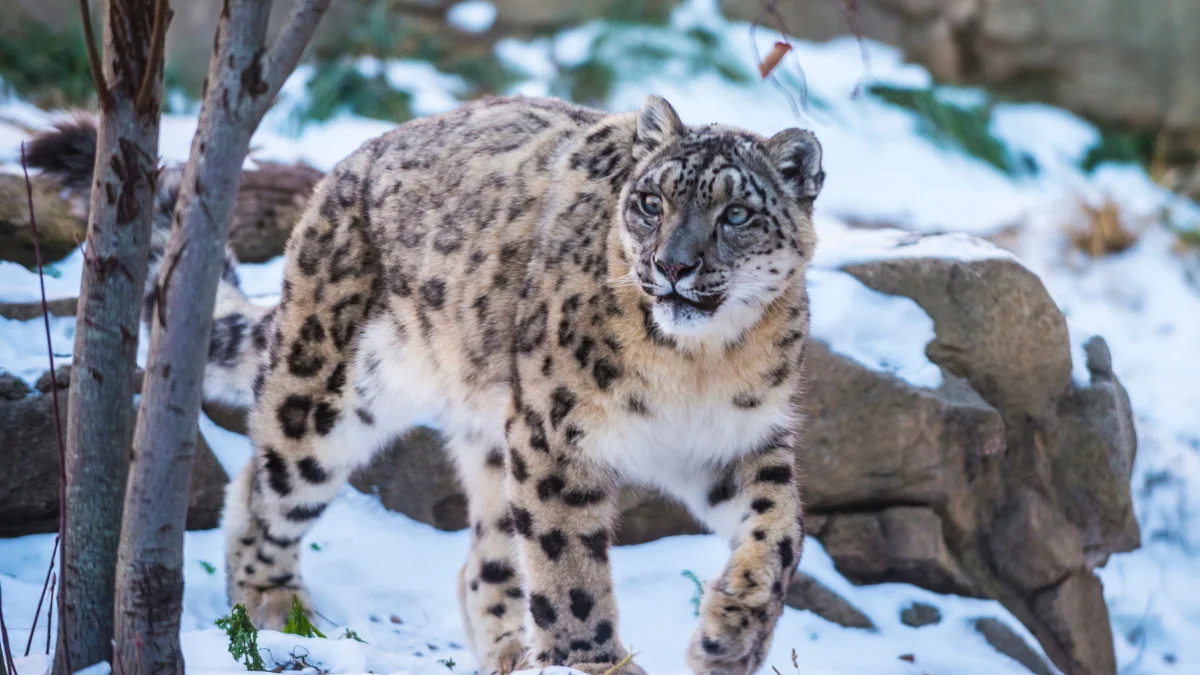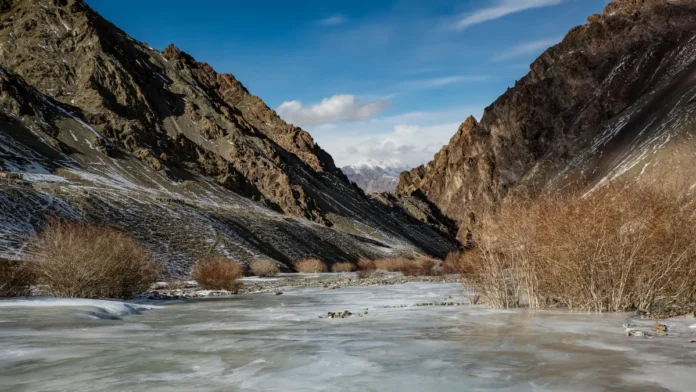Hemis National Park, situated at a height of 3,300 to 6,000 metres, is the highest park in the world and the largest in South Asia. Founded in 1981, it has six towns with a combined population of approximately 1600, offering beautiful camping areas and acting as a sanctuary for endangered snow leopards. Encompassing a four-century-old marvel, the ancient Hemis Monastery, the park artfully combines natural and cultural assets. In addition to its historical value, the park is a refuge for lovers of trekking and hiking, with a breathtakingly beautiful terrain. Hemis National Park, a destination of both ecological and cultural significance, is situated in the centre of this high wildness and serves as a witness to the delicate balance between biodiversity, human settlement, and historical legacy.
Hemis National Park Wildlife and Flora

Flora of Hemis National Park
Hemis National Park has a unique aridity because Ladakh, which is tucked away in the Himalayan rain shadow, receives very little rainfall. The park’s largely desolate terrain and areas covered in dry woods are striking examples of this natural feature. But when one drops to lower elevations, a stunning change appears, with lush fir trees standing out against the dry surroundings.
The two main tree species in the park’s lower elevation regions are Alpine and Steppe, which are well-suited to survive in dry, low-humidity environments. Their tenacity adds to Hemis National Park’s distinctive biological fabric. Among the many varieties of plants, the dry birch and juniper are particularly noteworthy since they are positioned to withstand harsh weather. Beyond these resilient trees, the park is home to various plant species that demonstrate the amazing adaptation of life in this harsh climate. These include medicinal and endangered types.
In addition to serving as a haven for biodiversity, Hemis National Park offers evidence of the coexistence of a wide variety of plant life despite the challenging climate of Ladakh. This delicate balance captures the spirit of this special national park by creating an environment where ecological significance and hardiness merge.
Fauna at Hemis National Park
For those who love animals, Hemis National Park is a highly sought-after destination because of its diversified and abundant fauna, in addition to its appealing sceneries. With so many uncommon and endangered species, the park provides a rare chance to see animals living in high-altitude environments.
There are about 16 kinds of mammals and 73 bird species in the park, which demonstrates its diverse wildlife. Visitors can marvel at the sight of bharal (blue sheep), Himalayan Mouse Hare, shapu (Ladakhi Urial), Eurasian Brown Bear, Himalayan Marmot, Tibetan Wolf, and Red Fox, among other important species, in addition to the elusive Snow Leopards that beautify its environment.
With sightings of the majestic Golden Eagle, fire-fronted serin, robin accentor, red-billed chough, lammergeier vulture, and streaked rosefinch, birdwatchers can find comfort in the avian delights of Hemis National Park. In the middle of Ladakh’s natural environment, the park offers a harmonic combination of adventure and tranquillity, making it a sanctuary for anyone looking to meet the unique and uncommon people who live there.
Snow Leopard Sightings in Hemis National Park

With its reputation as a global hotspot for snow leopard sightings, Hemis National Park provides a unique and exciting chance to see this elusive big cat in its native Himalayan environment. These amazing animals have a pristine sanctuary in the park’s mountainous and isolated terrain, and the park’s dedication to conservation guarantees a sustainable habitat for their survival. For those who are lucky enough to see them, the Snow Leopards, often known as the “Ghost of the Mountains” due to their elusiveness, provide an incredible display as they gracefully traverse the bleak terrain.
In Hemis National Park, guided wildlife trips and trekking adventures increase the likelihood of seeing snow leopards, especially in the winter when these secretive animals go down to lower altitudes in pursuit of food. The breathtaking Himalayan background and the uncommon visual encounter combine to make this a pilgrimage experience that appeals to both animal lovers and environmentalists. The fragile cohabitation of these magnificent animals with their surroundings is attested to by Hemis National Park, underscoring the need for ethical tourism in maintaining the allure of snow leopard sightings for future generations.
Hemis National Park Timings and Entry Fee
Depending on one’s nationality, there are different entrance costs for Hemis National Park. The admission price for Indian tourists is INR 20 per person. However, international visitors must pay INR 100 per person. This charge schedule aids the park’s upkeep and conservation efforts.
Monday to Friday, from 09:00 A.M. to 05:00 P.M., is when visitors can enter the park. This schedule guarantees that visitors to Hemis National Park will have enough daylight to explore the park’s unique flora and fauna while also respecting the hours set aside for the protection of animals and the welfare of both people and the natural environment. The entry prices and operation hours are designed to enable everyone who wants to immerse themselves in the special and alluring environment of Hemis National Park to have a responsible and enriching experience, regardless of whether they are travelling domestically or abroad.

Hemis National Park Safari
By adopting a policy of having no motorable roads inside its borders, Hemis National Park provides visitors with a singular and immersive experience. Since driving is not permitted within the park, visitors are encouraged to adopt a more environmentally conscious lifestyle and to have a closer relationship with the natural world. Trekkers have a variety of options for exploring this pristine environment; they can choose to travel around the park via many trails. The Grand La, a tall mountain pass located inside the park, is particularly noteworthy for adding to the attraction of hiking.
Seasonal passes make it easier to enter Grand La; the summer pass is available in June, and the winter ticket is available in April. It’s interesting to note that the summer pass and winter pass are only 500 metres apart, creating a dramatic change in the scenery. The Markha Valley hiking path, which connects the Rumbak and Skiu valleys, provides adventure seekers with a two-day excursion across the centre of the park. There are six villages inside the park, making camping close to these communities both easy and culturally enriching. Camping is allowed within the park, offering a chance to get back in touch with nature. Because of Hemis National Park’s dedication to sustainable tourism, visitors are encouraged to enjoy the park’s natural beauty by walking and camping, promoting peaceful coexistence between people and the pristine environment.
How to Reach Hemis National Park
Trekking:
There are several ways to go to Hemis National Park that can accommodate different tastes. An exciting option for adventure seekers looking for a fully immersed experience is to hike from Spituk Village to the national park. This walk gives hikers the opportunity to interact with the park’s surrounding natural beauties in addition to offering a picturesque tour through untamed landscapes.
By Air:
Many modes of travel make it easier to get to Hemis National Park. The closest airport to the park is located in Leh, about 5 kilometres away. There are regular flights from Leh to other international airports and important cities like Delhi and Mumbai, especially between June and September. But during the winter, when there are fewer flights to Leh, taking the road is a safer option.
By Road and Rail:
Buses, taxis and jeeps are among the ground transportation options accessible from Leh to go to the national park. The closest train station is in Haryana, yet most people want to avoid travelling there by train. If you would rather go by car, two major highways connect to Ladakh. They are both located close to the northern boundary of Hemis National Park. Both the 1D National Highway (open May to November) and the Leh-Manali Highway (open mid-June to October) offer beautiful roads that lead to the park, giving visitors the freedom to select their preferred mode of transportation depending on when they are visiting.
Best Time to Visit Hemis National Park
The best months to discover Hemis National Park’s treasures are May through September, when the temperature is pleasant, and the snow has melted, making for ideal viewing opportunities. Visitors may take advantage of the park’s varied scenery, clean trails, and great weather during this time. It’s the perfect time of year for nature lovers to experience the alluring appeal of this Himalayan refuge because of the verdant surroundings, blossoming flora, and attractive background for hiking and animal viewing.
Conclusion
Hemis National Park, located in the centre of the enigmatic Himalayas, entices visitors with its wild splendour and abundant wildlife. Every moment spent in this refuge is a brushstroke in the painting that is nature, from the elusive Snow Leopards gracefully crossing rough terrains to the brilliant flora embracing the pure surroundings. Whether you take the gorgeous Leh-Manali highway, the thrilling hike from Spituk Village, or the comforts of public conveyance, each option offers a different kind of adventure. With their pleasant temperatures and breathtaking views devoid of snow, the months of May through September make the ideal backdrop for travel and exploration. Immerse yourself in a sanctuary where nature’s treasures emerge at every turn as you take in the clean mountain air and watch the eternal dance of animals against the backdrop of Grand La. Hemis National Park promises an amazing trip into the heart of the Himalayas.





